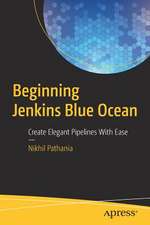Java How to Program, Early Objects, Global Edition
Autor Paul Deitelen Limba Engleză Paperback – 22 dec 2017
Unparalleled breadth and depth of object-oriented programming concepts
The Deitels' groundbreaking How to Program series offers unparalleled breadth and depth of programming fundamentals, object-oriented programming concepts and intermediate-level topics for further study. Java How to Program, Early Objects, 11th Edition, presents leading-edge computing technologies using the Deitel signature live-code approach, which demonstrates concepts in hundreds of complete working programs. The 11th Edition presents updated coverage of Java SE 8 and new Java SE 9 capabilities, including JShell, the Java Module System, and other key Java 9 topics. [Java How to Program, Late Objects, 11th Edition also is available.]
MyLab™ Programming not included. Students, if MyLab is a recommended/mandatory component of the course, please ask your instructor for the correct ISBN and course ID. MyLab should only be purchased when required by an instructor. Instructors, contact your Pearson rep for more information.
MyLab Programming is an online learning system designed to engage students and improve results. MyLab Programming consists of a set of programming exercises correlated to the programming concepts in this book. Through hundreds of practice problems, the system automatically detects errors in the logic and syntax of their code submissions and offers targeted hints that enable students to figure out what went wrong—and why.
Preț: 570.70 lei
Preț vechi: 655.98 lei
-13% Nou
Puncte Express: 856
Preț estimativ în valută:
109.22€ • 113.60$ • 90.17£
109.22€ • 113.60$ • 90.17£
Carte disponibilă
Livrare economică 25 martie-08 aprilie
Livrare express 08-14 martie pentru 77.02 lei
Preluare comenzi: 021 569.72.76
Specificații
ISBN-13: 9781292223858
ISBN-10: 1292223855
Pagini: 1296
Dimensiuni: 231 x 180 x 39 mm
Greutate: 1.87 kg
Ediția:11 ed
Editura: Pearson Education
ISBN-10: 1292223855
Pagini: 1296
Dimensiuni: 231 x 180 x 39 mm
Greutate: 1.87 kg
Ediția:11 ed
Editura: Pearson Education
Cuprins
1. Introduction to Computers, the Internet and Java
2. Introduction to Java Applications; Input/Output and Operators
3. Introduction to Classes, Objects, Methods and Strings
4. Control Statements: Part 1; Assignment, ++ and -- Operators
5. Control Statements: Part 2; Logical Operators
6. Methods: A Deeper Look
7. Arrays and ArrayLists
8. Classes and Objects: A Deeper Look
9. Object-Oriented Programming: Inheritance
10. Object-Oriented Programming: Polymorphism and Interfaces
11. Exception Handling: A Deeper Look
12. JavaFX Graphical User Interfaces: Part 1
13. JavaFX GUI: Part 2
14. Strings, Characters and Regular Expressions
15. Files, Input/Output Streams, NIO and XML Serialization
16. Generic Collections
17. Lambdas and Streams
18. Recursion
19. Searching, Sorting and Big O
20. Generic Classes and Methods: A Deeper Look
21. Custom Generic Data Structures
22. JavaFX Graphics and Multimedia
23. Concurrency
24. Accessing Databases with JDBC
25. Introduction to JShell: Java 9's REPL
Chapters on the Web
A. Operator Precedence Chart
B. ASCII Character Set
C. Keywords and Reserved Words
D. Primitive Types
E. Using the Debugger
Appendices on the Web
Index
Online Chapters and Appendices
26. Swing GUI Components: Part 1
27. Graphics and Java 2D
28. Networking
29. Java Persistence API (JPA)
30. JavaServer(TM) Faces Web Apps: Part 1
31. JavaServer(TM) Faces Web Apps: Part 2
32. REST-Based Web Services
33. (Optional) ATM Case Study, Part 1: Object-Oriented Design with the UML
34. (Optional) ATM Case Study, Part 2: Implementing an Object-Oriented Design
35. Swing GUI Components: Part 2
36. Java Module System and Other Java 9 Features
F. Using the Java API Documentation
G. Creating Documentation with javadoc
H. Unicode®
I. Formatted Output
J. Number Systems
K. Bit Manipulation
L. Labeled break and continue Statements
M. UML 2: Additional Diagram Types
N. Design Patterns
2. Introduction to Java Applications; Input/Output and Operators
3. Introduction to Classes, Objects, Methods and Strings
4. Control Statements: Part 1; Assignment, ++ and -- Operators
5. Control Statements: Part 2; Logical Operators
6. Methods: A Deeper Look
7. Arrays and ArrayLists
8. Classes and Objects: A Deeper Look
9. Object-Oriented Programming: Inheritance
10. Object-Oriented Programming: Polymorphism and Interfaces
11. Exception Handling: A Deeper Look
12. JavaFX Graphical User Interfaces: Part 1
13. JavaFX GUI: Part 2
14. Strings, Characters and Regular Expressions
15. Files, Input/Output Streams, NIO and XML Serialization
16. Generic Collections
17. Lambdas and Streams
18. Recursion
19. Searching, Sorting and Big O
20. Generic Classes and Methods: A Deeper Look
21. Custom Generic Data Structures
22. JavaFX Graphics and Multimedia
23. Concurrency
24. Accessing Databases with JDBC
25. Introduction to JShell: Java 9's REPL
Chapters on the Web
A. Operator Precedence Chart
B. ASCII Character Set
C. Keywords and Reserved Words
D. Primitive Types
E. Using the Debugger
Appendices on the Web
Index
Online Chapters and Appendices
26. Swing GUI Components: Part 1
27. Graphics and Java 2D
28. Networking
29. Java Persistence API (JPA)
30. JavaServer(TM) Faces Web Apps: Part 1
31. JavaServer(TM) Faces Web Apps: Part 2
32. REST-Based Web Services
33. (Optional) ATM Case Study, Part 1: Object-Oriented Design with the UML
34. (Optional) ATM Case Study, Part 2: Implementing an Object-Oriented Design
35. Swing GUI Components: Part 2
36. Java Module System and Other Java 9 Features
F. Using the Java API Documentation
G. Creating Documentation with javadoc
H. Unicode®
I. Formatted Output
J. Number Systems
K. Bit Manipulation
L. Labeled break and continue Statements
M. UML 2: Additional Diagram Types
N. Design Patterns





















